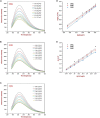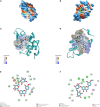Impacts of hesperidin on whey protein functionality: Interacting mechanism, antioxidant capacity, and emulsion stabilizing effects
- PMID: 36687727
- PMCID: PMC9846557
- DOI: 10.3389/fnut.2022.1043095
Impacts of hesperidin on whey protein functionality: Interacting mechanism, antioxidant capacity, and emulsion stabilizing effects
Abstract
The objective of this work was to explore the possibility of improving the antioxidant capacity and application of whey protein (WP) through non-covalent interactions with hesperidin (HES), a citrus polyphenol with nutraceutical activity. The interaction mechanism was elucidated using several spectroscopic methods and molecular docking analysis. The antioxidant capacity of the WP-HES complexes was analyzed and compared to that of the proteins alone. Moreover, the resistance of oil-in-water emulsions formulated using the WP-HES complexes as antioxidant emulsifiers to changes in environmental conditions (pH, ion strength, and oxidant) was evaluated. Our results showed that HES was incorporated into a single hydrophobic cavity in the WP molecule, where it was mainly held by hydrophobic attractive forces. As a result, the microenvironments of the non-polar tyrosine and tryptophan residues in the protein molecules were altered after complexation. Moreover, the α-helix and β-sheet regions in the protein decreased after complexation, while the β-turn and random regions increased. The antioxidant capacity of the WP-HES complexes was greater than that of the proteins alone. Non-radiative energy transfer from WP to HES was detected during complex formation. Compared to WP alone, the WP-HES complexes produced emulsions with smaller mean droplet diameters, exhibited higher pH and salt stability, and had better oxidative stability. The magnitude of these effects increased as the HES concentration was increased. This research would supply valuable information on the nature of the interactions between WP and HES. Moreover, it may lead to the creation of dual-function antioxidant emulsifiers for application in emulsified food products.
Keywords: emulsions; hesperidin; interaction; molecular docking technology; whey protein.
Copyright © 2023 Wang, Guo, Zhang, Yuan, Zhao, Bai and McClements.
Conflict of interest statement
The authors declare that the research was conducted in the absence of any commercial or financial relationships that could be construed as a potential conflict of interest.
Figures











Similar articles
-
Physical Modification of Whey Protein by Interacting with Methyl Hesperidin: Impacts on Antioxidant Activity and Underlying Mechanism.Biology (Basel). 2025 May 1;14(5):492. doi: 10.3390/biology14050492. Biology (Basel). 2025. PMID: 40427681 Free PMC article.
-
Surface characteristics and emulsifying properties of whey protein/nanoliposome complexes.Food Chem. 2022 Aug 1;384:132510. doi: 10.1016/j.foodchem.2022.132510. Epub 2022 Feb 19. Food Chem. 2022. PMID: 35217464
-
Influence of environmental pH on the interaction properties of WP-EGCG non-covalent nanocomplexes.J Sci Food Agric. 2023 Aug 30;103(11):5364-5375. doi: 10.1002/jsfa.12611. Epub 2023 Apr 26. J Sci Food Agric. 2023. PMID: 37029636
-
The interactions between anthocyanin and whey protein: A review.Compr Rev Food Sci Food Saf. 2021 Nov;20(6):5992-6011. doi: 10.1111/1541-4337.12854. Epub 2021 Oct 7. Compr Rev Food Sci Food Saf. 2021. PMID: 34622535 Review.
-
The non-covalent interactions between whey protein and various food functional ingredients.Food Chem. 2022 Nov 15;394:133455. doi: 10.1016/j.foodchem.2022.133455. Epub 2022 Jun 10. Food Chem. 2022. PMID: 35732088 Review.
Cited by
-
Physicochemical Properties of Nanoliposomes Encapsulating Grape Seed Tannins Formed with Ultrasound Cycles.Foods. 2024 Jan 27;13(3):414. doi: 10.3390/foods13030414. Foods. 2024. PMID: 38338549 Free PMC article.
-
Physical Modification of Whey Protein by Interacting with Methyl Hesperidin: Impacts on Antioxidant Activity and Underlying Mechanism.Biology (Basel). 2025 May 1;14(5):492. doi: 10.3390/biology14050492. Biology (Basel). 2025. PMID: 40427681 Free PMC article.
-
Enhancing Antioxidant Retention through Varied Wall Material Combinations in Grape Spray Drying and Storage.Antioxidants (Basel). 2023 Sep 10;12(9):1745. doi: 10.3390/antiox12091745. Antioxidants (Basel). 2023. PMID: 37760048 Free PMC article.
References
-
- Foegeding E, Luck P, Vardhanabhuti B. Milk protein products | whey protein products. Encyclopedia of dairy sciences (second edition). San Diego: Academic Press; (2011). 10.1016/B978-0-12-374407-4.00350-2 - DOI
-
- Bhatt H, Cucheval A, Coker C, Patel H, Carr A, Bennett R. Effect of micellar structure of casein and its modification on plasmin-induced hydrolysis. Int Dairy J. (2017) 75:75–82. 10.1016/j.idairyj.2017.07.009 - DOI
-
- Corfield R, Martínez K, Allievi M, Santagapita P, Mazzobre F, Schebor C, et al. Whey proteins-folic acid complexes: formation, isolation and bioavailability in a Lactobacillus casei model. Food Struct. (2020) 26:100162. 10.1016/j.foostr.2020.100162 - DOI
-
- Kong F, Kang S, An Y, Li W, Han H, Guan B, et al. The effect of non-covalent interactions of xylitol with whey protein and casein on structure and functionality of protein. Int Dairy J. (2020) 111:104841. 10.1016/j.idairyj.2020.104841 - DOI
LinkOut - more resources
Full Text Sources
Research Materials

